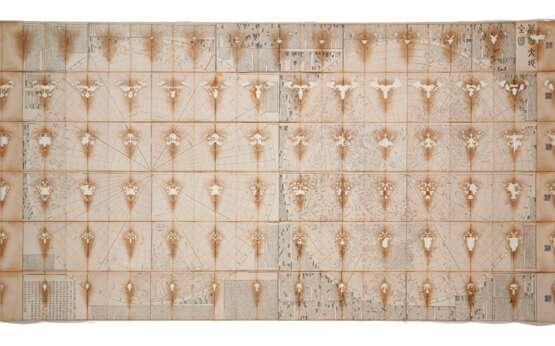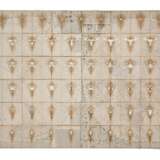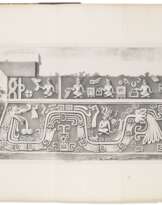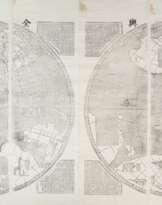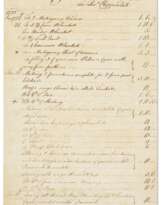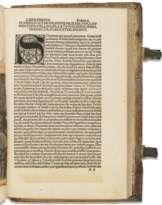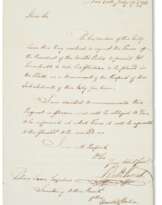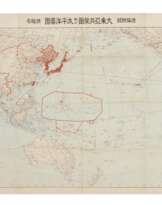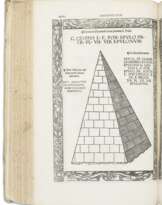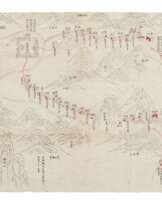ID 627596
Lot 107 | Complete Map of the World
Valeur estimée
$ 10 000 – 15 000
Extremely rare monumental map of the globe. It features two hemispheres defined by straight meridian and circular parallel lines and a ground of red grids. The left hemisphere centers on the south pole, while the right one on the north pole. Both hemispheres are bordered with the equator. The map adopts modern mapping techniques, including a conic equidistant projection and geographic coordinates. Place names on the two hemispheres are of different directions; those on the north hemisphere orient outwards, while the texts on the south hemisphere orient inwards. Such a configuration was probably inspired by the surface design of terrestrial globe. If one cuts the globe into two at the equator and place the two hemisphere aligned with the two poles facing the viewer, the text orientation would be the same as that of the present lot. In addition, the zero and 180 degree north are drawn on the opposite side of their south counterparts, with zero degree north at the top of the north hemisphere and 180 degree south at the top of the south hemisphere. If the two hemispheres in the map are cut out and pasted onto a globe, the orientations of text would become consistent. (Huang) The producer of this reprinted map is Liu Yan (or Liu Dezhi), an expert of terrestrial globe making and a student of Li Zhaoluo. The original cartographer is Ye Zipei, active in the 19th century. According to Liu Yan’s 1851 inscription at the top of the map, the famous world map Kunyu Quantu (Complete Map of the World) produced by Ferdinand Verbiest (1623-1688; for a later copy of this map, see lot 79 in the current sale) and Huangchao Yitong Yudi Quantu [Complete Map of the Unified Empire] by Li Zhaoluo (see lot 105) were the major inspirational resources of Ye Zipei’s map. However, Liu Yan may have largely changed Ye Zipei’s original design to what we see in the present lot, including the unusual composition with north and south hemispheres, and moving the detailed annotations from within the hemispheres to the margins of the map (Huang). The map was published three times: the first edition by Ye Zipei in 1845, which may not have been handed down; the second edition revised and released by Liu Yan in the third month of 1851, with two known extant copies, the first of which is the present lot and the other is a copy in the collection of Shijiazhuang Museum, Hebei Province (this copy is divided differently, into eight vertical strips); the third edition was also published by Liu Yan, in the autumn of 1851, renamed Dadi Quanqiu Yilan zhi Tu (Map with an Overview of the Whole Global World), a copy of which can be found in the collection of the National Palace Museum, Taipei. (Huang) Reference: Ying-Shi Huang, “Research on the Characteristic and Production of the “Universal Atlas” by Ye Zipei,” Bulletin of the Historical Association of the Republic of China, no. 42 (2010), pp. 185-230.
Woodblock map of the globe, printed on paper in red and black, comprising six accordion-style albums, each approx. 215 x 95 mm folded and 215 x 2600 mm unfolded for an overall size of approximately 1290 x 2600 mm or about 4 by 8.5 feet. Light brown front and rear covers for each album, with a white title strip on the front covers, title and sequence number written in ink by hand. The map includes rivers, mountains, and geometrical shapes representing administrative units, annotated with place names in Chinese. Texts on the four sides include information of countries and places. An inscription from Ye Zipei’s original version of the map is preserved and printed at the upper left corner, including texts by Ye Zipei himself, his brother Ye Yunshi, collector Tan Jing and Yu Hao. The map contains two inscriptions by Liu Yan in 1851, one next to Ye Zipei’s inscription and the other at the lower left corner. Collector’s seals appear on the flyleaf of each album. (Wormholes along folds with significant losses, all albums backed with rice paper, some chipping and tears along folds; paper browning, especially along the margins and wormholes; light staining on covers, title strips slightly chipping. Album one (the top row): the middle part of the title strip lost, the largest wormhole measures 40 x 70mm, on the title leaf. Album two: the largest wormhole 105 x 150mm. Album three: the largest wormhole 105 x 110mm. Album four: the largest wormhole 80 x 90mm. Album five: the largest wormhole 90 x 65mm. Album six: the largest wormhole 60 x 30mm.) Provenance: Nishiyama Gorō, 1864-1940, Tokyo, Japan (collector's stamp).
Please note that this lot is subject to an import tariff. If the buyer instructs Christie’s to arrange shipping of the lot to a foreign address, the buyer will not be required to pay the import tariff. If the buyer instructs Christie’s to arrange shipping of the lot to a domestic address, if the buyer collects the property in person, or if the buyer arranges their own shipping (whether domestically or internationally), the buyer will be required to pay the import tariff. Please contact Post Sale Services on +1 212 636 2650 prior to bidding for more information.
| Artiste: | William Shakespeare (1564 - 1616) |
|---|---|
| Technique appliquée: | Crayon |
| Artiste: | William Shakespeare (1564 - 1616) |
|---|---|
| Technique appliquée: | Crayon |
| Adresse de l'enchère |
CHRISTIE'S 8 King Street, St. James's SW1Y 6QT London Royaume-Uni | |
|---|---|---|
| Aperçu |
| |
| Téléphone | +44 (0)20 7839 9060 | |
| Commission | see on Website | |
| Conditions d'utilisation | Conditions d'utilisation |
